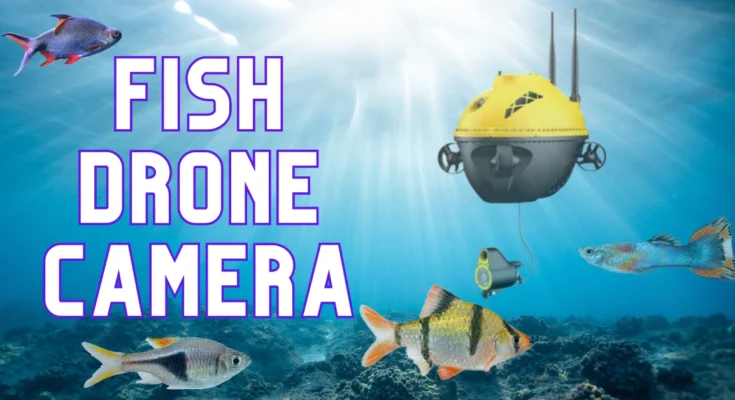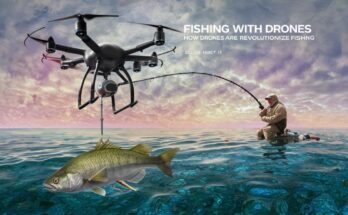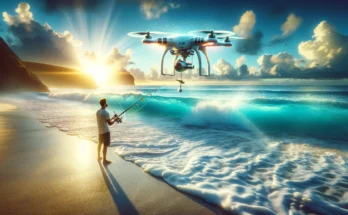Introduction
Under the boundless oceans of Earth lies a kingdom, yet to be explored and whose secrets are as yet unsolved. Human curiosity got us to go exploring down there, and it generated the development of rather sophisticated technologies that connect our world with these undersea lands.
The fish drone camera is one such technological marvel that has transformed underwater exploration. These imaging-enhanced antelopes of the oceans have provided us with a window into what lies within these alien worlds, given them entrance to places where traditional methods fall short.
As we explore deep down, making use of fish drone camera vigilance over the ruins therein to record and analyze for our future better understanding Life on Earth cannot be long ignored.
So just how do these fish drone cameras work? In this article we explore the ins and outs of fishery use.
Fish Drone Camera : A Technological Marvel
Fish drone cameras represent a technological marvel that seamlessly merges aquatic exploration with cutting-edge drone technology.
At their core, fish drone cameras are equipped with advanced imaging systems that mimic the streamlined design and movements of underwater creatures. This technology allows them to navigate through submerged environments with remarkable agility, capturing high-resolution footage and images.
Key features of fish drone cameras include waterproof casings, efficient propulsion systems, and sophisticated camera functionalities, often including high-definition video recording and live streaming capabilities.
Some models are equipped with adjustable lighting systems to adapt to different water conditions, while others boast obstacle avoidance mechanisms for enhanced maneuverability in complex underwater terrains. The ability to remotely control and communicate with these drones further amplifies their utility in underwater exploration.
The evolution of underwater drone technology has seen a significant leap in recent years, driven by advancements in materials, miniaturization, and communication systems.
From initial rudimentary models to today’s sleek and efficient fish drone cameras, this evolution reflects the ongoing commitment to overcoming the challenges posed by underwater exploration and unlocking the potential for deeper, more immersive discoveries in the world’s oceans.
Applications of Fish Drone Camera
Multifunctional applications Fish drone cameras have become an invaluable tool for different fields.
These drones are part of the front lines, both in scientific research and marine biology. Fish drone cameras enable scientists to observe marine life in its natural environment, revealing behaviors and migrations undreamt-of before.
Fish drone cameras are also used in environmental monitoring and protection work. Diverse intelligence from coral reefs by scanning marine life and observing biodiversity and the effects of human activities on ocean habitats, these drones provide invaluable information for formulating effective conservation policies. Information gathered by fish drone cameras helps in identifying and handling environmental threats quickly.
Outside the realms of science, fish drone cameras have found a place among recreational use and underwater video. Such drones are employed by enthusiasts and filmmakers to get stunning footage of underwater landscapes, marine life or even archaeological sites–perspectives that were once the exclusive preserve of professional divers. Its dual function of being both scientific and recreational highlights the adaptability, worthiness and innovative nature of fish drone cameras.
How Fish Drone Cameras Work
The design of fish drone cameras is meticulously crafted to emulate the streamlined and agile nature of aquatic life. Typically resembling fish or underwater creatures, these drones feature hydrodynamic shapes that minimize resistance in water, allowing for efficient movement through the depths.
The outer casing is robust and waterproof, safeguarding the internal electronics from the corrosive effects of saltwater.
Propulsion and maneuverability are critical aspects of fish drone camera functionality. Most models are equipped with propellers or thrusters that enable precise navigation and control. Some employ advanced propulsion systems that mimic the undulating movements of fish tails, enhancing their ability to navigate through intricate underwater environments.
The drones are designed to change depth, direction, and speed seamlessly, ensuring optimal maneuverability for capturing footage in diverse underwater conditions.
Underwater communication and control mechanisms are vital for remotely operating fish drone cameras. These drones often rely on wireless technologies and sensors to establish a communication link with a surface controller.
Advanced models feature real-time streaming capabilities, allowing users to view and control the drone’s movements while receiving live footage. These communication systems are designed to withstand the challenges of underwater environments, where signal interference and water pressure can pose significant hurdles.
Overall, the synergy of design, propulsion, and communication technologies enables fish drone cameras to navigate and explore underwater realms with precision and effectiveness.
Notable Fish Drone Camera Models
Several notable fish drone camera brands have emerged, each contributing to the advancement of underwater exploration technology. Brands like Power Vision, Chasing, and Geneinno have gained prominence for their innovative designs and cutting-edge features.
Power Vision’s Power Dolphin series, for instance, boasts a sleek and hydrodynamic design, making it a popular choice among both professionals and enthusiasts.
Chasing’s Gladius and Gladius Mini models are recognized for their compact size and advanced maneuverability, ideal for capturing intricate underwater landscapes. Geneinno’s Titan and Poseidon models are celebrated for their robust construction and high-resolution imaging capabilities.
When comparing features and specifications, certain aspects stand out among different fish drone camera models. The depth rating, maximum speed, battery life, and camera resolution are key parameters for potential users.
Some models offer 4K ultra-high-definition video recording, while others prioritize extended battery life for prolonged exploration sessions. The ability to explore at greater depths is a crucial factor for those interested in deep-sea exploration, and various models cater to different depth requirements.
User testimonials and experiences provide valuable insights into the practical performance of fish drone cameras. Enthusiasts often share their experiences with ease of use, durability, and the quality of footage captured.
Positive testimonials often highlight the user-friendly controls, while constructive feedback may address areas for improvement, such as enhanced obstacle avoidance or extended battery capabilities.
These user experiences play a pivotal role in shaping the reputation of fish drone camera models, guiding potential users in selecting the most suitable option for their specific needs.
Challenges and Limitations
Naturally, the exploration of underwater environments entails intrinsic environmental problems that affect fish drone cameras ‘performance. But the conditions under water are extremely harsh, with extreme pressures and corrosive saltwater coupled to a lack of visibility.
These challenges may decrease the longevity of drone parts, and even the quality of recorded images. Drones will need to utilize resilient materials as well as protective coverings in order to withstand the marine environment.
There are also technical limitations to fish drone cameras that make underwater exploration complex. Despite these advances, there are still some models that will encounter problems maintaining a stable communications link. Underwater signal strength weakens with depth, of course.
A third major drawback is battery life, which limits the duration of underwater expeditions. Furthermore, obstacles like rocks or marine vegetation can hinder drones ‘movement and put them at risk. Overcoming these technical limitations is of great importance to improving the overall effectiveness and reliability of fish drone cameras.
Though tricky, the road ahead for fish drone cameras is filled with a lot of promise and possibilities. R & D work continues to surmount environmental and technical obstacles.
Fish drone cameras are expected to see their operational capabilities extended by advances in materials engineering, communication technologies and power efficiency.
More advanced obstacle avoidance systems may be added to future models, making them safer when navigating complex underwater terrains.
Furthermore, breakthroughs in artificial intelligence and autonomous navigation could increase a fish drone camera’s overall decision-making power. Under water is not static, so the ability to adjust on the fly would help bring its true capabilities into better use.
While these improvements are being rolled out, fish drone cameras look set to assume an even larger role in increasing our knowledge of the undersea world.
Case Studies
Fish-Eye Drone Cameras have pioneered explorations under the waves, revealing otherwise inaccessible and elusive marine habitats. These had been used by researchers and explorers to explore areas that were previously hard or often impossible to reach.
Examples include research on deep-sea ecosystems, compilation of records about underwater caves and documentation of marine life in unexplored areas. It was the adaptability and mobility of fish drone cameras that has made breakthrough explorations possible.
The applications of fish drone cameras are not limited to exploration. They have even helped generate a wealth of scientific discoveries and environmental protection findings. From this data and footage, researchers have been able to analyze marine biodiversity, monitoring coral reefs and the health of underwater ecosystems.
This ability to collect current information helps identify environmental threats, so that remedial actions and conservation can be quickly undertaken. Today, fish drone cameras have become indispensable tools for researching and preserving the delicate balance of marine ecology.
They allow us to see the underwater world in incredible close-up. They capture high-definition footage and images of marine life, multi-colored coral reefs and beyond. It’s a feast for the eye to watch these drones in action.
Fish drone cameras grant equipment lovers, teachers and members of the general public access into the beauty and variety of sea life without having to get their feet wet.
This not only has an educational role, but also fosters a greater respect for the necessity of preserving these priceless underwater habitats. The awe-inspiring scenes captured by fish drone cameras are an eloquent expression of the role played by them in bringing underwater wonders to people wherever they live.
Tips for Using
Fish Drone Cameras
Preparation is everything in undertaking such an underwater expedition as this with fish drone cameras. It is a small container holding all of the various parts for assembling and maintaining drones. Before diving into bottomless depths, one must thoroughly inspect and test each component to make sure that everything is in order.
Lock the waterproof seals, battery life and control mechanisms to avoid technical problems underwater. Moreover, you must also consider the environmental conditions of your selected exploration site–the water temperature and currents there (and possible obstacles).
Taking high-quality footage with fish drone cameras requires great attention to detail and the application of standard procedures. According to the different lighting and depth conditions, adjust the camera settings for them.
Take advantage of the drone’s stabilization features to reduce vibrations and get smooth footage. Pre-plan the drone’s path. Best ensure adequate coverage of the target area. Approach your pets with patience and without intruding.
Trying out different angles and viewpoints can produce more interesting, lively footage.
Proper maintenance and care are requirements for the long service life of fish drone cameras. After every use, wash the drone in fresh water to get rid of salt and other corrosive substances.
Check the propellers, seals and casing for any wear or damage. Store the drone in a dry and cool place, and frequently upgrade firmware and software to take advantage of new enhancements or bug fixes.
Periodic calibration of sensors and thorough pre-flight checks will contribute to the overall performance and longevity of the fish drone camera. Following these tips ensures a smoother and more productive experience when using fish drone cameras for underwater exploration.
Future of Underwater Exploration
Fish drone camera technology is the future of underwater exploration. More intensive research and development should result in better imaging properties, higher resolution sensors and advanced communications systems.
Miniaturization and more power efficiency could lead to cheaper, smaller yet more powerful underwater drones that cover a larger area.
Artificial intelligence may also have a bearing on the issue of autonomous navigation. One example is fish drone cameras that can intelligently adapt to ever-changing underwater environments.
However, the trends in underwater exploration indicate a trend towards more expansive and integrated methods. Bringing together different technologies (including underwater robots, sensors and advanced mapping systems) means a more comprehensive understanding of marine ecosystems.
Such collaboration between scientists, engineers and environmentalists is expected only to increase. This should lead to better monitoring of underwater environments too.
In the face of environmental problems, joint actions towards preserving and understanding underwater ecosystems are assuming ever greater importance.
With the ability to gather valuable data and footage, fish drone cameras will be at the heart of these undertakings.
Collaboration between governmental organizations, research institutions and environmental groups may in time give rise to all-encompassing monitoring networks equipped with fish drone cameras that collect data as it is happening.
These joint efforts are designed not only to help us better understand the underwater world through science, but also will share this deeper scientific understanding and practical experience with other countries abroad so as to protect global ocean resources.
Conclusion
Therefore in the end, fish drone cameras have without question opened up a previously unimaginable frontier of underwater exploration.
Their value is in recreating the splendor of sea kingdoms, supplementary documentation on marine life and contribution to scientific research as well as environmental protection. The fish drone camera has solved the problem between human inquisitiveness and what lies hidden under the sea. It provides a unique vantage point that teaches us more about Earth’s massive bio diverse world.
In retrospect, looking back over what has been done with fish drone camera technology, there is a clear call for further study and development. The future may hold even more sophisticated advancements which will overcome current limitations and extend the scope of underwater investigation.
Striving to break new ground, expanding our capabilities and exploring the unknown of deep space remains an essential step. Together with this and other projects, the future of fish drone cameras is limitless.
Besides accurately showing the splendor of this watery realm, these technological marvels are also important allies in building a global consciousness about saving our oceans.
In exploring the unexplored regions below, fish drone cameras are a signal of innovation that ushers us towards greater familiarity with our planet’s final frontier.





One Comment on “Fish Drone Camera – Best Guide To Explore Underwater World”